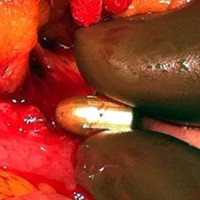Tube Pancreatico-Duodenostomy for Management of a Severe Penetrating Pancreaticoduodenal Injury
Abstract
Context Optimal management of penetrating pancreaticoduodenal injuries and better outcomes are associated with simple, fast damage control surgery and shorter operative time. The performance of pyloric exclusion and tube duodenostomy has markedly decreased. However, there is still a trend toward their performance in cases of delay duodenal repair or severe pancreaticoduodenal injury. Case report The present report describes a case of a hemodynamically stable patient with a single penetrating gunshot trauma causing an AAST-OIS grade III pancreatic head injury and grade IV injury of the second portion of the duodenum. The patient was treated in our Level IV rural trauma center and submitted to primary closure of the posterolateral duodenal wall (the laceration of the contralateral inner medial duodenal wall could not be repaired), external duodenal and pancreatic drainage, and duodenal decompression by tube pancreatico-duodenostomy (insertion of a 18 Fr Foley catheter through the laceration of the pancreatic head toward the duodenal lumen), tube cholangiostomy, and pyloric exclusion accompanied with a feeding jejunostomy. Conclusions Tube pancreatico-duodenostomy, which is described for the first time in the literature, turned out to be effective and can be considered as an option in pancreaticoduodenal trauma when the inner medial duodenal wall cannot be repaired.
Image: Gunshot.
Downloads
References
Lahiri R, Bhattacharya S. Pancreatic trauma. Ann R Coll Surg Engl 2013;95:241-245. [PMID: 23676806].
Degiannis E, Glapa M, Loukogeorgakis SP, Smith MD. Management of pancreatic trauma. Injury 2008; 39:21-29. PMID: 17996869.
Yilmaz TB, Hauer TJ, Smith MD, Degiannis E, Doll D. Operative techniques in pancreatic trauma-A heuristic approach. Injury 2013; 44:153-155. PMID: 23103081.
Blouhos K, Boulas KA, Konstantinidou A, Salpigktidis II, Katsaouni SP, et al. Early rupture of an ultralow duodenal stump after extended surgery for gastric cancer with duodenal invasion managed by tube duodenostomy and cholangiostomy. Case Rep Surg 2013; doi:10.1155/2013/430295. PMID: 24159410.
Bassi C, Dervenis C, Butturini G, Fingerhut A, Yeo C, et al. Postoperative pancreatic fistula: an international study group (ISGPF) definition. Surgery 2005; 138:8-13. PMID: 16003309.
Asensio JA, Petrone P, Roldán G, Pak-art R, Salim A. Pancreatic and duodenal injuries. complex and lethal. Scand J Surg 2002; 91:81-86. PMID: 12075842.
Fatovich DM, Phillips M, Langford SA, Jacobs IG. A comparison of metropolitan vs rural major trauma in Western Australia. Resuscitation 2011; 82:886-890. PMID: 21481512.
Asensio JA, Demetriades D, Hanpeter D, Gambaro, Chahwan S. Management of pancreatic injuries. Curr Probl Surg 1999; 36:325-419. PMID: 10410646.
Antonacci N, Di Saverio A, Ciaroni V, Biscardi A, Giugni A, et al. Prognosis and treatment of pancreaticoduodenal traumatic injuries:which factors are predictors of outcome? J Hepatobiliary Pancreat Sci 2011; 18:195-201. PMID: 20936305.
Chinnery GE, Mabida TE. Pancreaticoduodenal injuries: re-evaluating current management approaches. S Afr J Surg 2010; 48:10-14. PMID: 20496818.
Stawicki SP, Schwab CW. Pancreatic trauma:demographics, diagnosis, and management. Am Surg 2008; 74:1133-1145. PMID: 19097525.
Dubose JJ, Inaba K, Teixeira PG, Shiflett A, Putty B, et al. Pyloric Exclusion in the Treatment of Severe Duodenal Injuries: Results from the National Trauma Data Bank. Am Surg 2008; 74:925-929. PMID: 18942615.
Seamon MJ, Pieri PG, Fisher CA, Gaughan J, Santora TA, et al. A Ten-Year Retrospective Review:Does Pyloric Exclusion Improve Clinical Outcome After Penetrating Duodenal and Combined Pancreaticoduodenal Injuries? J Trauma 2007; 62:829-833. PMID: 17426536.
Velmahos GC, Constantinou C, Kasotakis G. Safety of repair for severe duodenal injuries. World J Surg 2008; 32:7-12. PMID: 17952703.
Girgin S, Gedik E, Yagmur Y, Uysal E, Baci B. Management of duodenal injury:our experience and the value of tube duodenostomy. Ulus Travma Acil Cerrahi Derg 2009; 15:467-472. PMID: 19779988.
Isik B, Yilmaz S, Kirimlioglu V, Sogutlu G, Yilmaz M, et al. A life-saving but inadequately discussed procedure: tube duodenostomy. Known and unknown aspects. World J Surg 2007; 31:1616-1624. PMID: 17566821.
Paluszkiewicz P. Should the tube cholangiostomy be performed as a supplement procedure to duodenostomy for treatment or prevention of duodenal fistula? World J Surg 2008; 32:1905. PMID: 18338204.

Copyright (c) 2014 Anestis Hatzigeorgiadis, Konstantinos A Boulas, Nikolaos Barettas, Irene Papageorgiou, Konstantinos Blouhos

This work is licensed under a Creative Commons Attribution 4.0 International License.
As a member of Publisher International Linking Association, PILA, iMedPub Group’s JOP follows the Creative Commons Attribution License and Scholars Open Access publishing policies. Journal of the Pancreas is the Council Contributor Member of Council of Science Editors (CSE) and following the CSE slogan Education, Ethics, and Evidence for Editors.